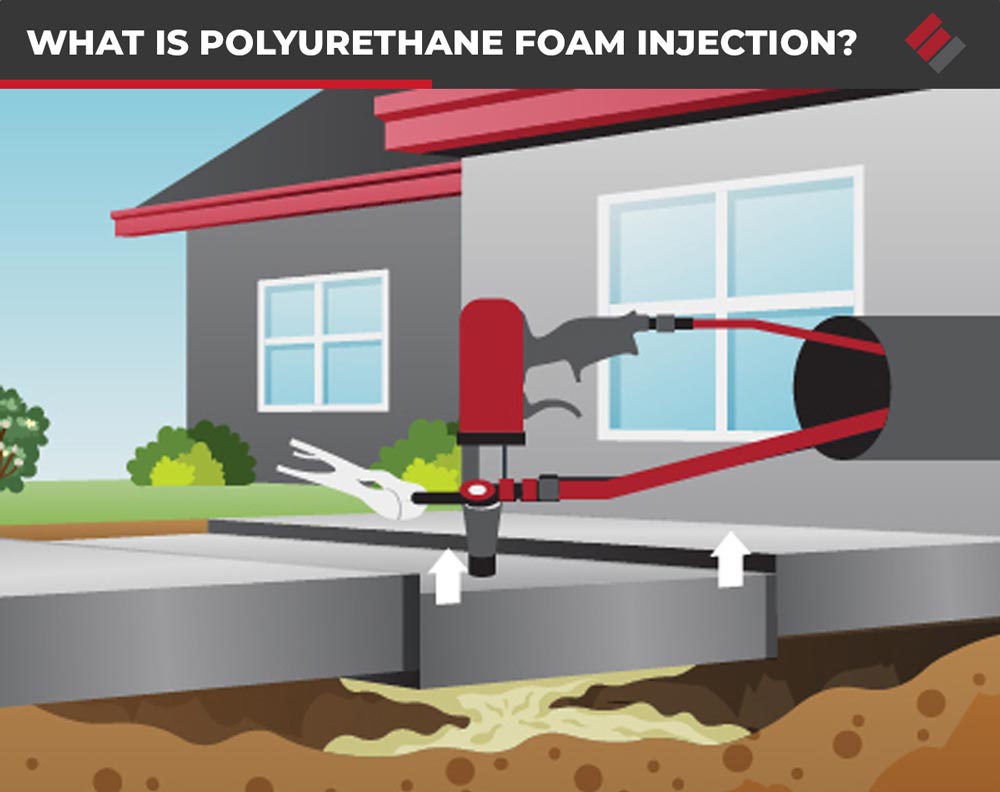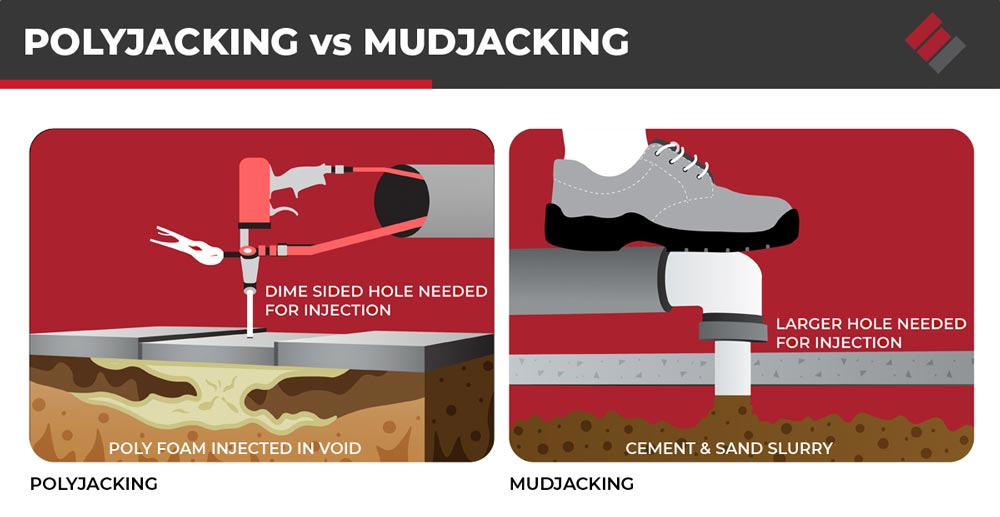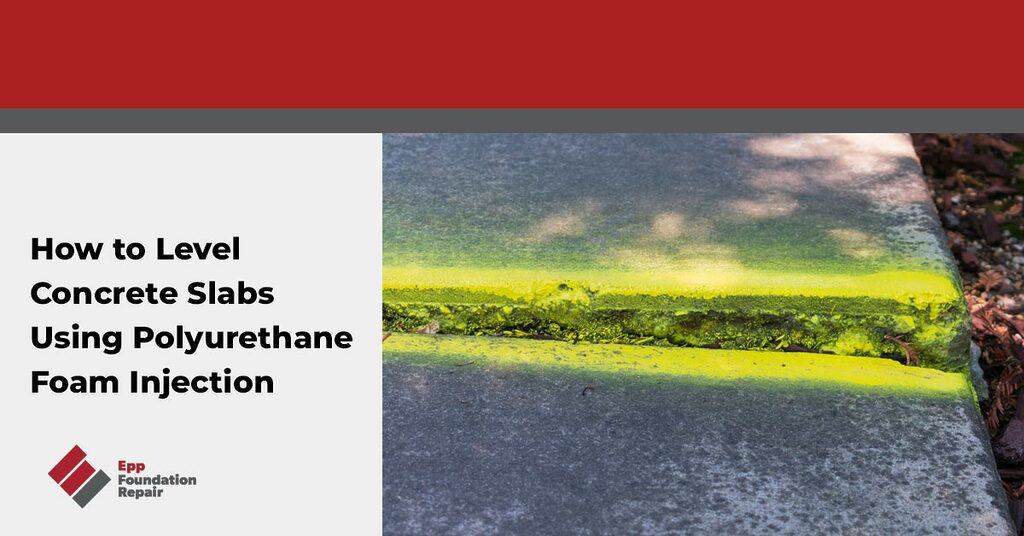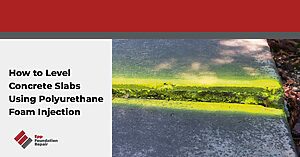Are you tired of looking at an uneven concrete surface on your property? Whether it’s your driveway, sidewalk, or patio, polyurethane foam injection can help level it in no time. With minimal disruption to existing landscaping and done in just a few hours, there are numerous advantages to leveling concrete using foam vs. digging up and replacing the slab. This article will cover why concrete slabs become uneven, how polyurethane foam injection works to level a slab, and more.
How Do Concrete Slabs Such as Sidewalks, Driveways, and Patios Become Uneven?
Expansive soil
One of the biggest perpetrators of concrete slab unevenness is expansive soil. This type of earth is composed of materials that expand and contract based on moisture content. When these soils get wet, they swell up, putting immense pressure on the concrete slab and pushing it upward. Conversely, when the soil dries up, it retracts, causing the slab to fall back down. This cycle of expansion and contraction can cause the slab to shift and become uneven over time.
Erosion-prone soil
Erosion-prone soil is another culprit for unevenness in concrete slabs. This type of dirt is composed of materials that are easily eroded by water. When the soil beneath a concrete slab erodes, it can cause the slab to sink and become uneven.
Improper site preparation
Soil needs to be compacted before a slab is poured. If this isn’t done correctly, the slab will settle into the ground and could become uneven.
Invasive tree roots
As trees grow, their roots can extend outwards, pushing up against concrete slabs. This can cause the slab to crack and become uneven over time. We’ve all seen examples of this.
Drought
When soil dries up due to a lack of water, it can shrink–and if the soil beneath a concrete slab shrinks, it can then lead to the slab becoming uneven.
Earthquakes
Anything that causes movement in the ground under a concrete slab can lead to unevenness.
What Is Polyurethane Foam Injection?

Polyurethane foam injection is a modern and reliable technique for leveling uneven concrete slabs. This method involves injecting polyurethane foam under the slab to raise it without the need for extensive and costly excavation. Once it is under the slab, the polyurethane foam expands and hardens to form a solid and stable base for the concrete. Polyurethane foam is highly durable and can withstand heavy loads and extreme weather conditions. It is ideal for leveling concrete slabs that have suffered from settling due to soil erosion or other environmental factors.
How Are Uneven Concrete Slabs Repaired Using Polyurethane Foam?
The process of repairing uneven concrete slabs using polyurethane foam has several steps that must be followed correctly to achieve a successful outcome:
1. Assessment – Before any repair work begins, a thorough assessment of the existing concrete slab must be conducted. This includes examining the extent and cause of the damage, as well as the soil conditions around the slab. This step is critical to ensuring that the application of the polyurethane foam is suitable for the specific situation.
2. Preparation – Once the assessment is made, preparation for the repair work can commence. The first step involves drilling dime-sized holes into the concrete slab to allow access for injecting the polyurethane foam. The number of holes required depends on the size of the affected area.
3. Injection – At this stage, the polyurethane foam is injected into the drilled holes under controlled conditions. The foam is injected into the spaces beneath the concrete slab, and expands and compresses against the soil to lift and level the slab. The foam injection must be accurately monitored to make sure it fills all voids under the slab.
4. Curing – The polyurethane foam requires time to cure and set, which usually takes about 15 minutes. During this process, the foam hardens, firmly fixing the newly-leveled concrete slab.
5. Patching and Cleanup – After the polyurethane foam has cured, the holes are then patched using a compound that closely matches the color of the slab. After that, any remaining debris or mess is cleaned up, restoring the surrounding area to how it was before the repair.
For more information, see our article Frequently Asked Questions About Concrete Leveling.
Is Polyurethane Foam Injection the Same as Mudjacking?
No, polyurethane foam injection is not the same as mudjacking. Mudjacking is an older method of lifting and leveling an uneven slab. It involves drilling holes into the concrete and pumping a mixture of cement, water, and soil underneath the slab to lift it back into place.
This process has been used for many years and is known to be effective, but it also has some downsides. For one, the mud can be messy, and can even cause damage to surrounding landscaping or structures.
Mudjacking uses heavy material that can weigh down the soil and cause additional settling. The polyurethane foam used in polyjacking is lightweight and lasts a lifetime. Additionally, the mud mixture takes time to dry and harden, leaving the slab unstable while it is still setting.

On the other hand, polyurethane foam injection is a newer technique that–as mentioned above–involves injecting a liquid polyurethane foam through small holes in the concrete. The foam quickly expands and hardens, creating a solid support structure under the slab. Unlike mudjacking, polyurethane foam injection is a clean, precise process that is less invasive and does not require heavy equipment. The foam also cures quickly, allowing for immediate use of the repaired area.
While mudjacking is still used today, polyurethane foam is the more common method of leveling uneven concrete surfaces.
For more information, see Concrete Lifting Foam: Why It’s Better Than Mudjacking?
How Much Does It Cost to Level an Uneven Concrete Slab Using Polyurethane Foam?
The cost of polyurethane foam leveling can vary depending on a few factors, such as the size of the slab, the severity of the unevenness, and the accessibility of the area. Prices typically range from $5 to $25 per square foot, with an average cost of around $10 to $15 per square foot.
It’s important to note that polyurethane foam leveling is not a DIY project, nor is it a job for your average handyman. A professional contractor should be hired to complete the work, as the process requires specialized equipment and expertise. However, the investment in professional foam leveling is often well worth it, as the results are long-lasting and can improve both the safety and the aesthetics of your concrete surface.
If you have an uneven concrete slab on your property, contact us today to schedule an evaluation and receive a free repair estimate. We serve areas in four states: Nebraska, Iowa, Kansas, and Missouri.







